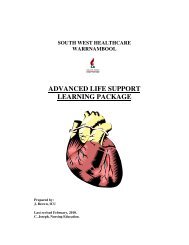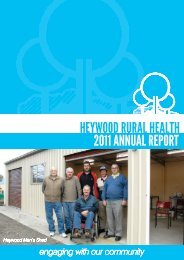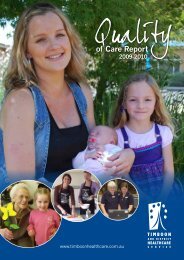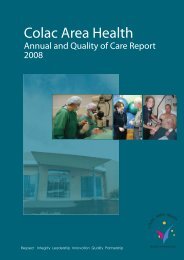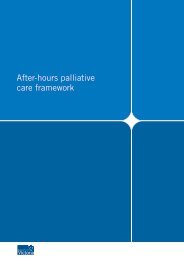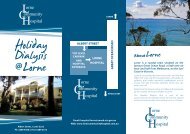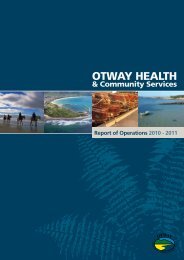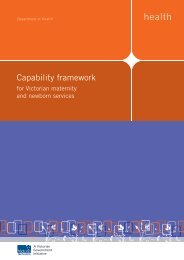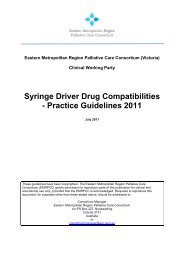Self Directed Learning Package - University of Queensland
Self Directed Learning Package - University of Queensland
Self Directed Learning Package - University of Queensland
- No tags were found...
Create successful ePaper yourself
Turn your PDF publications into a flip-book with our unique Google optimized e-Paper software.
100 • The Palliative Approach ToolkitEnvironmental strategies 19• lighting appropriate to time <strong>of</strong> day – windows with a view to outside, curtainsand blinds open during the day, and minimal lighting at night• quiet environment especially at night• provision <strong>of</strong> clock and calendar• avoid room changes• encourage family and friends to be involved in resident care• encourage family to bring in resident’s personal and familiar objects• staff caring for residents with delirium should establish a communication strategythat incorporates elements <strong>of</strong> both reality orientation and validation techniques• modify the environment to minimise risk <strong>of</strong> injury (nurse in a low bed with cot sidesdown, bed against the wall, potential hazards such as beside tables removed)• allow family members to stay with resident including overnight• endeavour to have the same staff members care for the resident during andacross shifts• information regarding the diagnosis, cause and management plan should becommunicated to the resident and their family.Clinical practice strategies 19• encourage/assist with eating and drinking to ensure adequate intake• ensure that residents who usually wear hearing and visual aids are assisted to usethem• regulation <strong>of</strong> bowel function – avoid constipation• encourage and assist with regular mobilisation unless the residents conditiondoes not warrant this• encourage independence in basic ADLs unless the residents condition does notwarrant this• medication review• promote relaxation and sufficient sleep – can be assisted by regular mobilisation,massage, encouraging wakefulness during the day• manage discomfort or pain• provide orienting information including name and role <strong>of</strong> staff members• minimise use <strong>of</strong> indwelling catheters• AVOID use <strong>of</strong> physical restraints• use interpreters and communication aids with CALD patients.Medications 19The primary aim <strong>of</strong> medications for delirium is to reduce theresident’s distress by targeting any agitation or hallucinations.Antipsychotic drugs are considered first line therapye.g. haloperidol, risperidone or olanzapine.Benzodiazepines do not improve cognition but may helpassociated anxietye.g. short acting agents such as lorazepam or midazolam areusually indicated.Key PointBenzodiazepines may worsen delirium if not used incombination with an antipsychotic drug.When all else failsSometimes agitation and delirium can cause such severe distressand does not respond to medical management, especially in theterminal phase. This is a challenging problem and may requiresedation as the only appropriate intervention.ActivityPlease spend some time reading the section on deliriumin “Therapeutic Guidelines: Palliative Care (version 3)” -included in the PA Toolkit.



